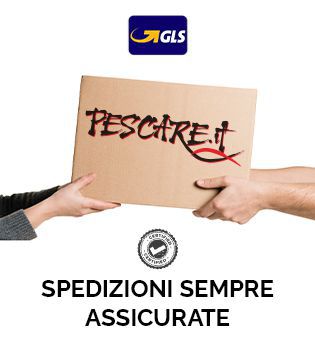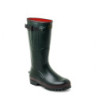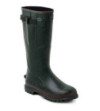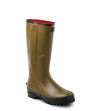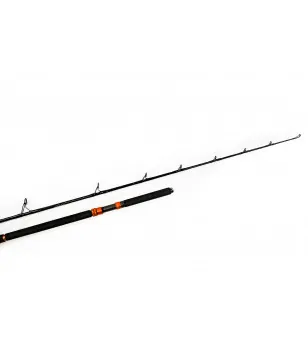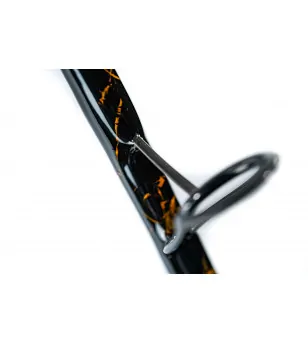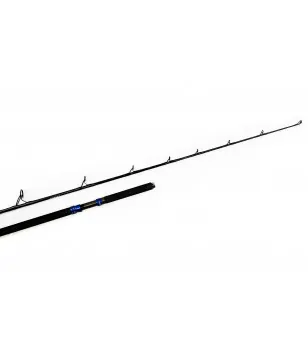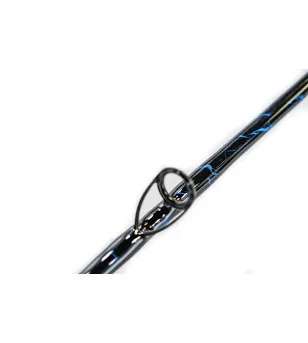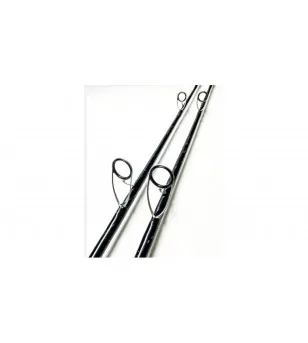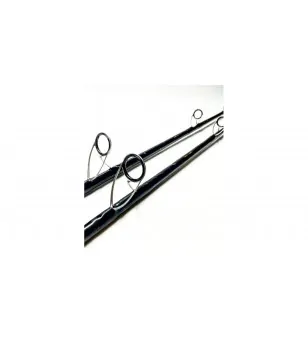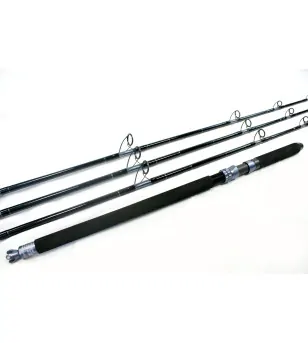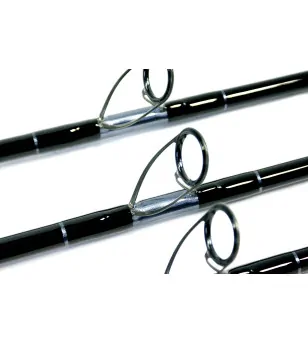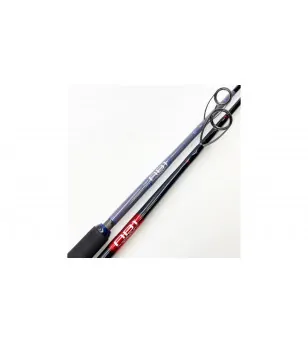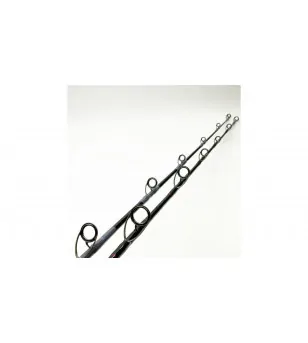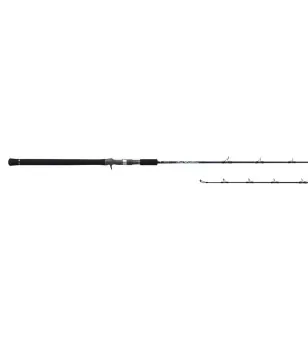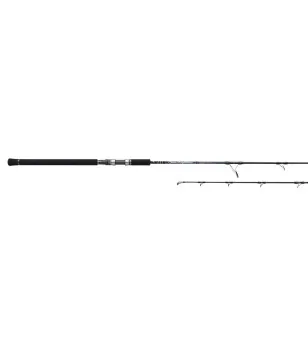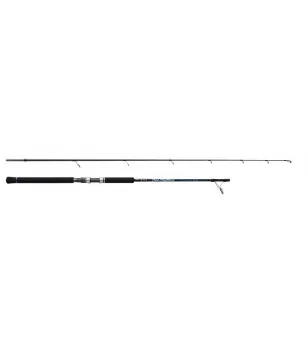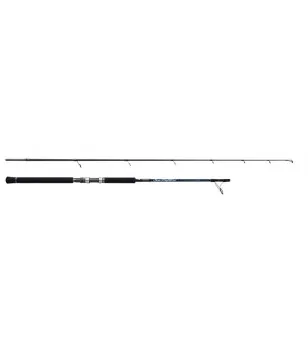Lingua:
AB1 MARBLE Prime Spinning Offshore
<p>AB1 sport fishing rods are specially built for maximum performance, they are not made in bulk production, Each blank is built one by one and tested on a dyno. (geometric wall). It is a unique constructional concept and very exclusive, combined with the AB1 components. The companys philosophy out of the series of commercial dynamics provides the starting point of which each individual rod is made, dressed with sartorial quality and providing it with proven and certified mechanical specifications. AB1 designs and builds its products in a 100% closed supply chain, 100% made in Italy: blanks and components: statically tested in the laboratories and dynamically at sea with the team of experts and elite sport fishermen affiliated to the company. The decision to buy an AB1 product is like a decision to have a tailored made suit, because it dresses the passion of a sport fisherman. AB1 employs a staff of highly qualified consultants in sport fishing who listen to the customer's needs, interacting with AB1 engineers and Rod Builders: AB1 thus offers the prototype of what will be the finished product. Choosing to buy an AB1 Rod is transforming your technical ideas into an executive project that will be YOUR fishing rod, unique and personal because YOUR ego is YOUR passion. AB1 TACKLE builds all there products 100% in Italy.Within its own closed supply chain, it designs and builds all the necessary components: the AB1 full floating roller guide system (world wide Patented) , the AB1 curved and straight butts are in structural carbon fiber, the AB1 reel seat and, the AB1 fighting belt also in full carbon fiber.Innovative and covered by international patents, the AB1 roller guides have a joint system that accompanies the flexing of a blank, making the blank work naturally like if there were no rollers on it., working smoothly with no tension that your normal conventional rollers create when bending the blank, also giving the rod a more powerful rebound when in battle! The AB1 handle in full structural carbon fiber, being made of composite material, does not interrupt the action of the blank, the handle compliments the action of the blank and reinforces the rebound with a synthesized flex, thus giving the rod a single-barrel characteristics and also the practicality of being dismantled in two pieces. The AB1 reel seat in structural carbon fiber, built one by one layering the fabrics, does not interrupt the action of the blank at the fixing point, it flexes at the same time and increases the speed of the reaction.The AB1 structural carbon real seat, to be used with a single-stem blank, does not affect the designed action of the blank, interacts at 40° of flexion of the blank and gives a powerful thrust avoiding parabolic phenomena and power gaps. The structure of the ab1 blanks are layed out one by one. The composite materials for higher performance, for structural applications are those formed by a discontinuos phase consisting of fiber (carbon) and a continuos phase called matrix (polymer). The production technologies that provide for the combination of the matrix with fibers arranged according to the predetermined directions during the structural calculation phase, allow to make composites with mechanical properties finalized, that is: - the mechanical properties of fibers (carbon 1K 1000 microwires to build ONE) - their orientation - their length - the mechanical properties of the polymechanical matrix - the chemical properties of the matrix - the behavior of the interface between fiber and matrix (adhesion) Carbon fibers can be classified according to the precursor material used in the production phase, which can be pitch, rayon, PAN.Epoxy resins belong to the class of thermosetting resins and are prepared from low molecular weight and low viscosity agents so that they can easily engage the fibers.EPOXY RESINS are more expensive than the most common polyester or phenolic resins but, unlike these, they have a very high adhesion and better chemical resistance, as well as a high dimensional stability, a very important characteristic for a composite material.Generally carbon fibers are not used as they are but are processed with textile looms in order to obtain real fabrics (weft and warp interface).When the quantity of fibers in one direction (generally the warp) becomes predominant, UNIDIRECTIONAL FABRICS occur.These types of fabrics allow you to take full advantage of the mechanical characteristics of the fibers along precise directions.Along the other directions, fibers of different material may also be present in order to maintain the dimensional stability of the dry material without diminishing the drapeability.THE MAIN ADVANTAGE of UNIDIRECTIONAL FABRICS is the possibility of being able to POSITION the optimal quantity of fibers exactly WHERE THEIR PROPERTIES are required and are macroscopically STRAIGHT. Le canne per la pesca sportiva AB1 sono costruite utilizzando blanks progettati specificatamente per ogni attrezzo della gamma: non sono commerciali e a catalogo, ma realizzati dall'ingegneria AB1 con caratteristiche meccaniche specifiche. E' un concetto costruttivo unico, che diventa esclusivo nell'attrezzo finito con i componenti AB1. La filosofia aziendale “fuori dalle serialità delle dinamiche commerciali”, costituisce il punto di partenza con cui viene realizzato ogni singolo attrezzo. La qualità sartoriale di ogni singolo pezzo è garantita anche identificandolo con specifiche e certificate prove meccaniche. AB1 progetta e costruisce al 100% in una filiera chiusa, 100% made in Italy: blanks, componenti, custom personalizzato. Inoltre, effettua una verifica statica nei laboratori e dinamica in mare con il Team di esperti e titolati pescatori sportivi affiliati all'azienda. La scelta di acquistare un attrezzo AB1 si equipara alla decisione di farsi confezionare un abito sartoriale poiché veste la passione del pescatore sportivo, dall'estetica della livrea alle performance tecniche specifiche per tipologia di pesca. AB1 si avvale di uno staff di consulenti, altamente qualificati nella pesca sportiva che ascoltano le esigenze del cliente, interagiscono con gli ingegneri AB1 e il Rod Builder: AB1 propone così il prototipo di quello che sarà l'attrezzo finito. Scegliere di acquistare un attrezzo AB1 è trasformare le tue idee tecniche in progetto esecutivo e sarà la TUA canna da pesca, unica e personale perché rappresenta il TUO ego e la TUA passione. Le canne per la pesca sportiva AB1 sono costruite utilizzando blanks progettati specificatamente per ogni attrezzo della gamma: non sono commerciali e a catalogo, ma realizzati dall'ingegneria AB1 con caratteristiche meccaniche specifiche. E' un concetto costruttivo unico, che diventa esclusivo nell'attrezzo finito con i componenti AB1. La filosofia aziendale “fuori dalle serialità delle dinamiche commerciali”, costituisce il punto di partenza con cui viene realizzato ogni singolo attrezzo. La qualità sartoriale di ogni singolo pezzo è garantita anche identificandolo con specifiche e certificate prove meccaniche. AB1 progetta e costruisce al 100% in una filiera chiusa, 100% made in Italy: blanks, componenti, custom personalizzato. Inoltre, effettua una verifica statica nei laboratori e dinamica in mare con il Team di esperti e titolati pescatori sportivi affiliati all'azienda. La scelta di acquistare un attrezzo AB1 si equipara alla decisione di farsi confezionare un abito sartoriale poiché veste la passione del pescatore sportivo, dall'estetica della livrea alle performance tecniche specifiche per tipologia di pesca. AB1 si avvale di uno staff di consulenti, altamente qualificati nella pesca sportiva che ascoltano le esigenze del cliente, interagiscono con gli ingegneri AB1 e il Rod Builder: AB1 propone così il prototipo di quello che sarà l'attrezzo finito. Scegliere di acquistare un attrezzo AB1 è trasformare le tue idee tecniche in progetto esecutivo e sarà la TUA canna da pesca, unica e personale perché rappresenta il TUO ego e la TUA passione. AB1 TACKLE costruisce i propri componenti 100% made in Italy. All'interno di una propria filiera chiusa, progetta e costruisce tutti i componenti necessari: il passante guida filo roller AB1, il manico curvo e/o dritto, il porta mulinello ed il pedone passante tutti realizzati in carbonio strutturale AB1. Innovativi e coperti da brevetto internazionale, I roller AB1 hanno un sistema basculante che accompagna la flessione del blank nei vari punti dell'asse, evitando quindi l'insorgere di vizi meccanici che ne comprometterebbero le caratteristiche progettuali. I roller AB1 sono adatti per l'utilizzo sia del monofilo che del dyneema. Il manico AB1 in carbonio strutturale, essendo costruito in materiale composito, non interrompe l'azione del blank al bicchierino di innesto, ma prosegue fino alla crocera, conferendo così all'attrezzo le caratteristiche mono fusto e comunque la praticità di essere smontato in due pezzi. Il porta mulinello AB1 in carbonio strutturale, costruito in forma stratificando i tessuti, non interrompe l'azione del blank nel punto di fissaggio, flette e nel contempo incrementa la velocità della reazione. Il pedone passante AB1 in carbonio strutturale, da utilizzare con blank mono fusto, non pregiudica l'azione progettuale dell'attrezzo, ma interviene oltre i 40° di flessione del manico e imprime una spinta poderosa evitando fenomeni parabolici e vuoti di potenza. I materiali compositi per applicazioni strutturali, a più elevate prestazioni, sono quelli formati da una fase discontinua costituita da FIBRE (carbonio) e una fase Continua detta MATRICE (POLIMERICA). Le tecnologie di produzione che prevedono la combinazione della matrice con fibre disposte secondo direzioni predeterminate in fase di calcolo strutturale, permettono di REALIZZARE COMPOSITI CON PROPRIETA' MECCANICHE FINALIZZATE che dipendono dai componenti utilizzati per la loro produzione, ovvero : - le proprietà meccaniche delle fibre (carbonio 1K 1000 microfili per costruirne UNO) - il loro orientamento - la loro lunghezza - le proprietà meccaniche della matrice polimerica - le proprietà chimiche della matrice - il comportamento dell'interfaccia fra fibra e matrice (adesione) Le fibre di carbonio si possono classificare in base al materiale precursore utilizzato in fase di produzione, che può essere pece , rayon , PAN. Le resine epossidiche appartengono alla classe delle resine termoindurenti sono preparate a partire da reagenti a basso peso molecolare e a bassa viscosità in modo che possano facilmente impregnare le fibre. Le resine epossidiche, più costose delle commerciali resine poliesteri o fenoliche, possiedono caratteristiche uniche tra le quali un‘ elevata aderenza e una migliore resistenza chimica, oltre ad un’ elevata stabilità dimensionale, caratteristica molto importante per un materiale composito. Generalmente le fibre di carbonio non vengono utilizzate così come sono ma vengono processate con i telai tessili al fine di ottenere dei veri e propri tessuti (interfaccia di trama e ordito). Quando la quantità di fibre in una direzione (generalmente l'ordito) diventano predominanti , si hanno TESSUTI UNIDIREZIONALI. Questi tipi di tessuti permettono di sfruttare appieno LE CARATTERISTICHE MECCANICHE DELLE FIBRE LUNGO DIREZIONI PRECISE. Lungo le altre direzioni possono essere presenti anche delle fibre di materiale differente con lo scopo di mantenere la stabilità dimensionale del materiale a secco senza però diminuire la drappeggiabilità. IL PRINCIPALE VANTAGGIO dei TESSUTI UNIDIREZIONALI è la possibilità di potere POSIZIONARE la quantità ottimale di fibre esattamente DOVE LE LORO PROPRIETA' sono richieste e sono macroscopicamente DRITTE. Reel Seat full carbon fiber Fuji Sic Unidirectional structure Blank Pry acid system Each blank tested on goniometric wall Under wrap resined one by one Triple wrap resined one by one 3 hands of Ultra V finish</p><table><thead class="pestit"><tr><td>Modello</td><td>Modello</td><td>Lunghezza</td><td>Best Drag</td><td>Max Drag</td><td>Fighting Drag</td><td>Fast Limited</td></tr></thead><tbody class="pestxt"><tr><td>AB1 MARBLE Prime Spinning Offshore</td><td>Prime Spinning Offshore</td><td>2.3 MT / 7'5''</td><td>4 KG / 8 LBS</td><td>9 KG / 19 LBS </td><td>3-8 KG / 6-17 LBS</td><td></td></tr></tbody></table>
Prezzo
750,00 €
 0 recensione
0 recensione
AB1 MARBLE Prime Spinning Tuna
<p>AB1 sport fishing rods are specially built for maximum performance, they are not made in bulk production, Each blank is built one by one and tested on a dyno. (geometric wall). It is a unique constructional concept and very exclusive, combined with the AB1 components. The companys philosophy out of the series of commercial dynamics provides the starting point of which each individual rod is made, dressed with sartorial quality and providing it with proven and certified mechanical specifications. AB1 designs and builds its products in a 100% closed supply chain, 100% made in Italy: blanks and components: statically tested in the laboratories and dynamically at sea with the team of experts and elite sport fishermen affiliated to the company. The decision to buy an AB1 product is like a decision to have a tailored made suit, because it dresses the passion of a sport fisherman. AB1 employs a staff of highly qualified consultants in sport fishing who listen to the customer's needs, interacting with AB1 engineers and Rod Builders: AB1 thus offers the prototype of what will be the finished product. Choosing to buy an AB1 Rod is transforming your technical ideas into an executive project that will be YOUR fishing rod, unique and personal because YOUR ego is YOUR passion. AB1 TACKLE builds all there products 100% in Italy.Within its own closed supply chain, it designs and builds all the necessary components: the AB1 full floating roller guide system (world wide Patented) , the AB1 curved and straight butts are in structural carbon fiber, the AB1 reel seat and, the AB1 fighting belt also in full carbon fiber.Innovative and covered by international patents, the AB1 roller guides have a joint system that accompanies the flexing of a blank, making the blank work naturally like if there were no rollers on it., working smoothly with no tension that your normal conventional rollers create when bending the blank, also giving the rod a more powerful rebound when in battle! The AB1 handle in full structural carbon fiber, being made of composite material, does not interrupt the action of the blank, the handle compliments the action of the blank and reinforces the rebound with a synthesized flex, thus giving the rod a single-barrel characteristics and also the practicality of being dismantled in two pieces. The AB1 reel seat in structural carbon fiber, built one by one layering the fabrics, does not interrupt the action of the blank at the fixing point, it flexes at the same time and increases the speed of the reaction.The AB1 structural carbon real seat, to be used with a single-stem blank, does not affect the designed action of the blank, interacts at 40° of flexion of the blank and gives a powerful thrust avoiding parabolic phenomena and power gaps. The structure of the ab1 blanks are layed out one by one. The composite materials for higher performance, for structural applications are those formed by a discontinuos phase consisting of fiber (carbon) and a continuos phase called matrix (polymer). The production technologies that provide for the combination of the matrix with fibers arranged according to the predetermined directions during the structural calculation phase, allow to make composites with mechanical properties finalized, that is: - the mechanical properties of fibers (carbon 1K 1000 microwires to build ONE) - their orientation - their length - the mechanical properties of the polymechanical matrix - the chemical properties of the matrix - the behavior of the interface between fiber and matrix (adhesion) Carbon fibers can be classified according to the precursor material used in the production phase, which can be pitch, rayon, PAN.Epoxy resins belong to the class of thermosetting resins and are prepared from low molecular weight and low viscosity agents so that they can easily engage the fibers.EPOXY RESINS are more expensive than the most common polyester or phenolic resins but, unlike these, they have a very high adhesion and better chemical resistance, as well as a high dimensional stability, a very important characteristic for a composite material.Generally carbon fibers are not used as they are but are processed with textile looms in order to obtain real fabrics (weft and warp interface).When the quantity of fibers in one direction (generally the warp) becomes predominant, UNIDIRECTIONAL FABRICS occur.These types of fabrics allow you to take full advantage of the mechanical characteristics of the fibers along precise directions.Along the other directions, fibers of different material may also be present in order to maintain the dimensional stability of the dry material without diminishing the drapeability.THE MAIN ADVANTAGE of UNIDIRECTIONAL FABRICS is the possibility of being able to POSITION the optimal quantity of fibers exactly WHERE THEIR PROPERTIES are required and are macroscopically STRAIGHT. Le canne per la pesca sportiva AB1 sono costruite utilizzando blanks progettati specificatamente per ogni attrezzo della gamma: non sono commerciali e a catalogo, ma realizzati dall'ingegneria AB1 con caratteristiche meccaniche specifiche. E' un concetto costruttivo unico, che diventa esclusivo nell'attrezzo finito con i componenti AB1. La filosofia aziendale “fuori dalle serialità delle dinamiche commerciali”, costituisce il punto di partenza con cui viene realizzato ogni singolo attrezzo. La qualità sartoriale di ogni singolo pezzo è garantita anche identificandolo con specifiche e certificate prove meccaniche. AB1 progetta e costruisce al 100% in una filiera chiusa, 100% made in Italy: blanks, componenti, custom personalizzato. Inoltre, effettua una verifica statica nei laboratori e dinamica in mare con il Team di esperti e titolati pescatori sportivi affiliati all'azienda. La scelta di acquistare un attrezzo AB1 si equipara alla decisione di farsi confezionare un abito sartoriale poiché veste la passione del pescatore sportivo, dall'estetica della livrea alle performance tecniche specifiche per tipologia di pesca. AB1 si avvale di uno staff di consulenti, altamente qualificati nella pesca sportiva che ascoltano le esigenze del cliente, interagiscono con gli ingegneri AB1 e il Rod Builder: AB1 propone così il prototipo di quello che sarà l'attrezzo finito. Scegliere di acquistare un attrezzo AB1 è trasformare le tue idee tecniche in progetto esecutivo e sarà la TUA canna da pesca, unica e personale perché rappresenta il TUO ego e la TUA passione. Le canne per la pesca sportiva AB1 sono costruite utilizzando blanks progettati specificatamente per ogni attrezzo della gamma: non sono commerciali e a catalogo, ma realizzati dall'ingegneria AB1 con caratteristiche meccaniche specifiche. E' un concetto costruttivo unico, che diventa esclusivo nell'attrezzo finito con i componenti AB1. La filosofia aziendale “fuori dalle serialità delle dinamiche commerciali”, costituisce il punto di partenza con cui viene realizzato ogni singolo attrezzo. La qualità sartoriale di ogni singolo pezzo è garantita anche identificandolo con specifiche e certificate prove meccaniche. AB1 progetta e costruisce al 100% in una filiera chiusa, 100% made in Italy: blanks, componenti, custom personalizzato. Inoltre, effettua una verifica statica nei laboratori e dinamica in mare con il Team di esperti e titolati pescatori sportivi affiliati all'azienda. La scelta di acquistare un attrezzo AB1 si equipara alla decisione di farsi confezionare un abito sartoriale poiché veste la passione del pescatore sportivo, dall'estetica della livrea alle performance tecniche specifiche per tipologia di pesca. AB1 si avvale di uno staff di consulenti, altamente qualificati nella pesca sportiva che ascoltano le esigenze del cliente, interagiscono con gli ingegneri AB1 e il Rod Builder: AB1 propone così il prototipo di quello che sarà l'attrezzo finito. Scegliere di acquistare un attrezzo AB1 è trasformare le tue idee tecniche in progetto esecutivo e sarà la TUA canna da pesca, unica e personale perché rappresenta il TUO ego e la TUA passione. AB1 TACKLE costruisce i propri componenti 100% made in Italy. All'interno di una propria filiera chiusa, progetta e costruisce tutti i componenti necessari: il passante guida filo roller AB1, il manico curvo e/o dritto, il porta mulinello ed il pedone passante tutti realizzati in carbonio strutturale AB1. Innovativi e coperti da brevetto internazionale, I roller AB1 hanno un sistema basculante che accompagna la flessione del blank nei vari punti dell'asse, evitando quindi l'insorgere di vizi meccanici che ne comprometterebbero le caratteristiche progettuali. I roller AB1 sono adatti per l'utilizzo sia del monofilo che del dyneema. Il manico AB1 in carbonio strutturale, essendo costruito in materiale composito, non interrompe l'azione del blank al bicchierino di innesto, ma prosegue fino alla crocera, conferendo così all'attrezzo le caratteristiche mono fusto e comunque la praticità di essere smontato in due pezzi. Il porta mulinello AB1 in carbonio strutturale, costruito in forma stratificando i tessuti, non interrompe l'azione del blank nel punto di fissaggio, flette e nel contempo incrementa la velocità della reazione. Il pedone passante AB1 in carbonio strutturale, da utilizzare con blank mono fusto, non pregiudica l'azione progettuale dell'attrezzo, ma interviene oltre i 40° di flessione del manico e imprime una spinta poderosa evitando fenomeni parabolici e vuoti di potenza. I materiali compositi per applicazioni strutturali, a più elevate prestazioni, sono quelli formati da una fase discontinua costituita da FIBRE (carbonio) e una fase Continua detta MATRICE (POLIMERICA). Le tecnologie di produzione che prevedono la combinazione della matrice con fibre disposte secondo direzioni predeterminate in fase di calcolo strutturale, permettono di REALIZZARE COMPOSITI CON PROPRIETA' MECCANICHE FINALIZZATE che dipendono dai componenti utilizzati per la loro produzione, ovvero : - le proprietà meccaniche delle fibre (carbonio 1K 1000 microfili per costruirne UNO) - il loro orientamento - la loro lunghezza - le proprietà meccaniche della matrice polimerica - le proprietà chimiche della matrice - il comportamento dell'interfaccia fra fibra e matrice (adesione) Le fibre di carbonio si possono classificare in base al materiale precursore utilizzato in fase di produzione, che può essere pece , rayon , PAN. Le resine epossidiche appartengono alla classe delle resine termoindurenti sono preparate a partire da reagenti a basso peso molecolare e a bassa viscosità in modo che possano facilmente impregnare le fibre. Le resine epossidiche, più costose delle commerciali resine poliesteri o fenoliche, possiedono caratteristiche uniche tra le quali un‘ elevata aderenza e una migliore resistenza chimica, oltre ad un’ elevata stabilità dimensionale, caratteristica molto importante per un materiale composito. Generalmente le fibre di carbonio non vengono utilizzate così come sono ma vengono processate con i telai tessili al fine di ottenere dei veri e propri tessuti (interfaccia di trama e ordito). Quando la quantità di fibre in una direzione (generalmente l'ordito) diventano predominanti , si hanno TESSUTI UNIDIREZIONALI. Questi tipi di tessuti permettono di sfruttare appieno LE CARATTERISTICHE MECCANICHE DELLE FIBRE LUNGO DIREZIONI PRECISE. Lungo le altre direzioni possono essere presenti anche delle fibre di materiale differente con lo scopo di mantenere la stabilità dimensionale del materiale a secco senza però diminuire la drappeggiabilità. IL PRINCIPALE VANTAGGIO dei TESSUTI UNIDIREZIONALI è la possibilità di potere POSIZIONARE la quantità ottimale di fibre esattamente DOVE LE LORO PROPRIETA' sono richieste e sono macroscopicamente DRITTE. Reel Seat full carbon fiber Fuji Sic Unidirectional structure Blank Pry acid system Each blank tested on goniometric wall Under wrap resined one by one Triple wrap resined one by one 3 hands of Ultra V finish</p><table><thead class="pestit"><tr><td>Modello</td><td>Modello</td><td>Lunghezza</td><td>Best Drag</td><td>Max Drag</td><td>Fighting Drag</td><td>Fast Limited</td></tr></thead><tbody class="pestxt"><tr><td>AB1 MARBLE Prime Spinning Tuna</td><td>Prime Spinning Tuna</td><td>2.3 MT / 7'5''</td><td>6 KG / 13 LBS</td><td>12 KG / 26 LBS </td><td>5-10 KG / 11-22 LBS</td><td></td></tr></tbody></table>
Prezzo
750,00 €
 0 recensione
0 recensione
AB1 GTS
<p>AB1 sport fishing rods are specially built for maximum performance, they are not made in bulk production, Each blank is built one by one and tested on a dyno. (geometric wall). It is a unique constructional concept and very exclusive, combined with the AB1 components. The companys philosophy out of the series of commercial dynamics provides the starting point of which each individual rod is made, dressed with sartorial quality and providing it with proven and certified mechanical specifications. AB1 designs and builds its products in a 100% closed supply chain, 100% made in Italy: blanks and components: statically tested in the laboratories and dynamically at sea with the team of experts and elite sport fishermen affiliated to the company. The decision to buy an AB1 product is like a decision to have a tailored made suit, because it dresses the passion of a sport fisherman. AB1 employs a staff of highly qualified consultants in sport fishing who listen to the customer's needs, interacting with AB1 engineers and Rod Builders: AB1 thus offers the prototype of what will be the finished product. Choosing to buy an AB1 Rod is transforming your technical ideas into an executive project that will be YOUR fishing rod, unique and personal because YOUR ego is YOUR passion. AB1 TACKLE builds all there products 100% in Italy.Within its own closed supply chain, it designs and builds all the necessary components: the AB1 full floating roller guide system (world wide Patented) , the AB1 curved and straight butts are in structural carbon fiber, the AB1 reel seat and, the AB1 fighting belt also in full carbon fiber.Innovative and covered by international patents, the AB1 roller guides have a joint system that accompanies the flexing of a blank, making the blank work naturally like if there were no rollers on it., working smoothly with no tension that your normal conventional rollers create when bending the blank, also giving the rod a more powerful rebound when in battle! The AB1 handle in full structural carbon fiber, being made of composite material, does not interrupt the action of the blank, the handle compliments the action of the blank and reinforces the rebound with a synthesized flex, thus giving the rod a single-barrel characteristics and also the practicality of being dismantled in two pieces. The AB1 reel seat in structural carbon fiber, built one by one layering the fabrics, does not interrupt the action of the blank at the fixing point, it flexes at the same time and increases the speed of the reaction.The AB1 structural carbon real seat, to be used with a single-stem blank, does not affect the designed action of the blank, interacts at 40° of flexion of the blank and gives a powerful thrust avoiding parabolic phenomena and power gaps. The structure of the ab1 blanks are layed out one by one. The composite materials for higher performance, for structural applications are those formed by a discontinuos phase consisting of fiber (carbon) and a continuos phase called matrix (polymer). The production technologies that provide for the combination of the matrix with fibers arranged according to the predetermined directions during the structural calculation phase, allow to make composites with mechanical properties finalized, that is: - the mechanical properties of fibers (carbon 1K 1000 microwires to build ONE) - their orientation - their length - the mechanical properties of the polymechanical matrix - the chemical properties of the matrix - the behavior of the interface between fiber and matrix (adhesion) Carbon fibers can be classified according to the precursor material used in the production phase, which can be pitch, rayon, PAN.Epoxy resins belong to the class of thermosetting resins and are prepared from low molecular weight and low viscosity agents so that they can easily engage the fibers.EPOXY RESINS are more expensive than the most common polyester or phenolic resins but, unlike these, they have a very high adhesion and better chemical resistance, as well as a high dimensional stability, a very important characteristic for a composite material.Generally carbon fibers are not used as they are but are processed with textile looms in order to obtain real fabrics (weft and warp interface).When the quantity of fibers in one direction (generally the warp) becomes predominant, UNIDIRECTIONAL FABRICS occur.These types of fabrics allow you to take full advantage of the mechanical characteristics of the fibers along precise directions.Along the other directions, fibers of different material may also be present in order to maintain the dimensional stability of the dry material without diminishing the drapeability.THE MAIN ADVANTAGE of UNIDIRECTIONAL FABRICS is the possibility of being able to POSITION the optimal quantity of fibers exactly WHERE THEIR PROPERTIES are required and are macroscopically STRAIGHT. Le canne per la pesca sportiva AB1 sono costruite utilizzando blanks progettati specificatamente per ogni attrezzo della gamma: non sono commerciali e a catalogo, ma realizzati dall'ingegneria AB1 con caratteristiche meccaniche specifiche. E' un concetto costruttivo unico, che diventa esclusivo nell'attrezzo finito con i componenti AB1. La filosofia aziendale “fuori dalle serialità delle dinamiche commerciali”, costituisce il punto di partenza con cui viene realizzato ogni singolo attrezzo. La qualità sartoriale di ogni singolo pezzo è garantita anche identificandolo con specifiche e certificate prove meccaniche. AB1 progetta e costruisce al 100% in una filiera chiusa, 100% made in Italy: blanks, componenti, custom personalizzato. Inoltre, effettua una verifica statica nei laboratori e dinamica in mare con il Team di esperti e titolati pescatori sportivi affiliati all'azienda. La scelta di acquistare un attrezzo AB1 si equipara alla decisione di farsi confezionare un abito sartoriale poiché veste la passione del pescatore sportivo, dall'estetica della livrea alle performance tecniche specifiche per tipologia di pesca. AB1 si avvale di uno staff di consulenti, altamente qualificati nella pesca sportiva che ascoltano le esigenze del cliente, interagiscono con gli ingegneri AB1 e il Rod Builder: AB1 propone così il prototipo di quello che sarà l'attrezzo finito. Scegliere di acquistare un attrezzo AB1 è trasformare le tue idee tecniche in progetto esecutivo e sarà la TUA canna da pesca, unica e personale perché rappresenta il TUO ego e la TUA passione. Le canne per la pesca sportiva AB1 sono costruite utilizzando blanks progettati specificatamente per ogni attrezzo della gamma: non sono commerciali e a catalogo, ma realizzati dall'ingegneria AB1 con caratteristiche meccaniche specifiche. E' un concetto costruttivo unico, che diventa esclusivo nell'attrezzo finito con i componenti AB1. La filosofia aziendale “fuori dalle serialità delle dinamiche commerciali”, costituisce il punto di partenza con cui viene realizzato ogni singolo attrezzo. La qualità sartoriale di ogni singolo pezzo è garantita anche identificandolo con specifiche e certificate prove meccaniche. AB1 progetta e costruisce al 100% in una filiera chiusa, 100% made in Italy: blanks, componenti, custom personalizzato. Inoltre, effettua una verifica statica nei laboratori e dinamica in mare con il Team di esperti e titolati pescatori sportivi affiliati all'azienda. La scelta di acquistare un attrezzo AB1 si equipara alla decisione di farsi confezionare un abito sartoriale poiché veste la passione del pescatore sportivo, dall'estetica della livrea alle performance tecniche specifiche per tipologia di pesca. AB1 si avvale di uno staff di consulenti, altamente qualificati nella pesca sportiva che ascoltano le esigenze del cliente, interagiscono con gli ingegneri AB1 e il Rod Builder: AB1 propone così il prototipo di quello che sarà l'attrezzo finito. Scegliere di acquistare un attrezzo AB1 è trasformare le tue idee tecniche in progetto esecutivo e sarà la TUA canna da pesca, unica e personale perché rappresenta il TUO ego e la TUA passione. AB1 TACKLE costruisce i propri componenti 100% made in Italy. All'interno di una propria filiera chiusa, progetta e costruisce tutti i componenti necessari: il passante guida filo roller AB1, il manico curvo e/o dritto, il porta mulinello ed il pedone passante tutti realizzati in carbonio strutturale AB1. Innovativi e coperti da brevetto internazionale, I roller AB1 hanno un sistema basculante che accompagna la flessione del blank nei vari punti dell'asse, evitando quindi l'insorgere di vizi meccanici che ne comprometterebbero le caratteristiche progettuali. I roller AB1 sono adatti per l'utilizzo sia del monofilo che del dyneema. Il manico AB1 in carbonio strutturale, essendo costruito in materiale composito, non interrompe l'azione del blank al bicchierino di innesto, ma prosegue fino alla crocera, conferendo così all'attrezzo le caratteristiche mono fusto e comunque la praticità di essere smontato in due pezzi. Il porta mulinello AB1 in carbonio strutturale, costruito in forma stratificando i tessuti, non interrompe l'azione del blank nel punto di fissaggio, flette e nel contempo incrementa la velocità della reazione. Il pedone passante AB1 in carbonio strutturale, da utilizzare con blank mono fusto, non pregiudica l'azione progettuale dell'attrezzo, ma interviene oltre i 40° di flessione del manico e imprime una spinta poderosa evitando fenomeni parabolici e vuoti di potenza. I materiali compositi per applicazioni strutturali, a più elevate prestazioni, sono quelli formati da una fase discontinua costituita da FIBRE (carbonio) e una fase Continua detta MATRICE (POLIMERICA). Le tecnologie di produzione che prevedono la combinazione della matrice con fibre disposte secondo direzioni predeterminate in fase di calcolo strutturale, permettono di REALIZZARE COMPOSITI CON PROPRIETA' MECCANICHE FINALIZZATE che dipendono dai componenti utilizzati per la loro produzione, ovvero : - le proprietà meccaniche delle fibre (carbonio 1K 1000 microfili per costruirne UNO) - il loro orientamento - la loro lunghezza - le proprietà meccaniche della matrice polimerica - le proprietà chimiche della matrice - il comportamento dell'interfaccia fra fibra e matrice (adesione) Le fibre di carbonio si possono classificare in base al materiale precursore utilizzato in fase di produzione, che può essere pece , rayon , PAN. Le resine epossidiche appartengono alla classe delle resine termoindurenti sono preparate a partire da reagenti a basso peso molecolare e a bassa viscosità in modo che possano facilmente impregnare le fibre. Le resine epossidiche, più costose delle commerciali resine poliesteri o fenoliche, possiedono caratteristiche uniche tra le quali un‘ elevata aderenza e una migliore resistenza chimica, oltre ad un’ elevata stabilità dimensionale, caratteristica molto importante per un materiale composito. Generalmente le fibre di carbonio non vengono utilizzate così come sono ma vengono processate con i telai tessili al fine di ottenere dei veri e propri tessuti (interfaccia di trama e ordito). Quando la quantità di fibre in una direzione (generalmente l'ordito) diventano predominanti , si hanno TESSUTI UNIDIREZIONALI. Questi tipi di tessuti permettono di sfruttare appieno LE CARATTERISTICHE MECCANICHE DELLE FIBRE LUNGO DIREZIONI PRECISE. Lungo le altre direzioni possono essere presenti anche delle fibre di materiale differente con lo scopo di mantenere la stabilità dimensionale del materiale a secco senza però diminuire la drappeggiabilità. IL PRINCIPALE VANTAGGIO dei TESSUTI UNIDIREZIONALI è la possibilità di potere POSIZIONARE la quantità ottimale di fibre esattamente DOVE LE LORO PROPRIETA' sono richieste e sono macroscopicamente DRITTE. Reel Seat full carbon fiber Fuji Sic Unidirectional structure Blank Pry acid system Each blank tested on goniometric wall Under wrap resined one by one Triple wrap resined one by one 3 hands of Ultra V finish</p><table><thead class="pestit"><tr><td>Modello</td><td>Modello</td><td>Lunghezza</td><td>Best Drag</td><td>Max Drag</td><td>Fighting Drag</td><td>Fast Limited</td></tr></thead><tbody class="pestxt"><tr><td>AB1 GTS 8 SB</td><td>GT 8 SB</td><td>7'8''</td><td>6 KG / 13 LBS</td><td>12 KG / 26 LBS </td><td>5-10 KG / 11-22 LBS</td><td>160-250 GR / 2,6 - 8,8 OZ</td></tr><tr><td>AB1 GTS 10 SB</td><td>GT 10 SB</td><td>7'8''</td><td>8 KG / 17 LBS</td><td>14 KG / 30 LBS</td><td>6-13 KG / 13-28 LBS</td><td>200-300 GR / 7-10,5 OZ</td></tr></tbody></table>
Prezzo
1.060,00 €
 0 recensione
0 recensione
AB1 Game Tuna Game
<p>AB1 sport fishing rods are specially built for maximum performance, they are not made in bulk production, Each blank is built one by one and tested on a dyno. (geometric wall). It is a unique constructional concept and very exclusive, combined with the AB1 components. The companys philosophy out of the series of commercial dynamics provides the starting point of which each individual rod is made, dressed with sartorial quality and providing it with proven and certified mechanical specifications. AB1 designs and builds its products in a 100% closed supply chain, 100% made in Italy: blanks and components: statically tested in the laboratories and dynamically at sea with the team of experts and elite sport fishermen affiliated to the company. The decision to buy an AB1 product is like a decision to have a tailored made suit, because it dresses the passion of a sport fisherman. AB1 employs a staff of highly qualified consultants in sport fishing who listen to the customer's needs, interacting with AB1 engineers and Rod Builders: AB1 thus offers the prototype of what will be the finished product. Choosing to buy an AB1 Rod is transforming your technical ideas into an executive project that will be YOUR fishing rod, unique and personal because YOUR ego is YOUR passion. AB1 TACKLE builds all there products 100% in Italy.Within its own closed supply chain, it designs and builds all the necessary components: the AB1 full floating roller guide system (world wide Patented) , the AB1 curved and straight butts are in structural carbon fiber, the AB1 reel seat and, the AB1 fighting belt also in full carbon fiber.Innovative and covered by international patents, the AB1 roller guides have a joint system that accompanies the flexing of a blank, making the blank work naturally like if there were no rollers on it., working smoothly with no tension that your normal conventional rollers create when bending the blank, also giving the rod a more powerful rebound when in battle! The AB1 handle in full structural carbon fiber, being made of composite material, does not interrupt the action of the blank, the handle compliments the action of the blank and reinforces the rebound with a synthesized flex, thus giving the rod a single-barrel characteristics and also the practicality of being dismantled in two pieces. The AB1 reel seat in structural carbon fiber, built one by one layering the fabrics, does not interrupt the action of the blank at the fixing point, it flexes at the same time and increases the speed of the reaction.The AB1 structural carbon real seat, to be used with a single-stem blank, does not affect the designed action of the blank, interacts at 40° of flexion of the blank and gives a powerful thrust avoiding parabolic phenomena and power gaps. The structure of the ab1 blanks are layed out one by one. The composite materials for higher performance, for structural applications are those formed by a discontinuos phase consisting of fiber (carbon) and a continuos phase called matrix (polymer). The production technologies that provide for the combination of the matrix with fibers arranged according to the predetermined directions during the structural calculation phase, allow to make composites with mechanical properties finalized, that is: - the mechanical properties of fibers (carbon 1K 1000 microwires to build ONE) - their orientation - their length - the mechanical properties of the polymechanical matrix - the chemical properties of the matrix - the behavior of the interface between fiber and matrix (adhesion) Carbon fibers can be classified according to the precursor material used in the production phase, which can be pitch, rayon, PAN.Epoxy resins belong to the class of thermosetting resins and are prepared from low molecular weight and low viscosity agents so that they can easily engage the fibers.EPOXY RESINS are more expensive than the most common polyester or phenolic resins but, unlike these, they have a very high adhesion and better chemical resistance, as well as a high dimensional stability, a very important characteristic for a composite material.Generally carbon fibers are not used as they are but are processed with textile looms in order to obtain real fabrics (weft and warp interface).When the quantity of fibers in one direction (generally the warp) becomes predominant, UNIDIRECTIONAL FABRICS occur.These types of fabrics allow you to take full advantage of the mechanical characteristics of the fibers along precise directions.Along the other directions, fibers of different material may also be present in order to maintain the dimensional stability of the dry material without diminishing the drapeability.THE MAIN ADVANTAGE of UNIDIRECTIONAL FABRICS is the possibility of being able to POSITION the optimal quantity of fibers exactly WHERE THEIR PROPERTIES are required and are macroscopically STRAIGHT. Le canne per la pesca sportiva AB1 sono costruite utilizzando blanks progettati specificatamente per ogni attrezzo della gamma: non sono commerciali e a catalogo, ma realizzati dall'ingegneria AB1 con caratteristiche meccaniche specifiche. E' un concetto costruttivo unico, che diventa esclusivo nell'attrezzo finito con i componenti AB1. La filosofia aziendale “fuori dalle serialità delle dinamiche commerciali”, costituisce il punto di partenza con cui viene realizzato ogni singolo attrezzo. La qualità sartoriale di ogni singolo pezzo è garantita anche identificandolo con specifiche e certificate prove meccaniche. AB1 progetta e costruisce al 100% in una filiera chiusa, 100% made in Italy: blanks, componenti, custom personalizzato. Inoltre, effettua una verifica statica nei laboratori e dinamica in mare con il Team di esperti e titolati pescatori sportivi affiliati all'azienda. La scelta di acquistare un attrezzo AB1 si equipara alla decisione di farsi confezionare un abito sartoriale poiché veste la passione del pescatore sportivo, dall'estetica della livrea alle performance tecniche specifiche per tipologia di pesca. AB1 si avvale di uno staff di consulenti, altamente qualificati nella pesca sportiva che ascoltano le esigenze del cliente, interagiscono con gli ingegneri AB1 e il Rod Builder: AB1 propone così il prototipo di quello che sarà l'attrezzo finito. Scegliere di acquistare un attrezzo AB1 è trasformare le tue idee tecniche in progetto esecutivo e sarà la TUA canna da pesca, unica e personale perché rappresenta il TUO ego e la TUA passione. Le canne per la pesca sportiva AB1 sono costruite utilizzando blanks progettati specificatamente per ogni attrezzo della gamma: non sono commerciali e a catalogo, ma realizzati dall'ingegneria AB1 con caratteristiche meccaniche specifiche. E' un concetto costruttivo unico, che diventa esclusivo nell'attrezzo finito con i componenti AB1. La filosofia aziendale “fuori dalle serialità delle dinamiche commerciali”, costituisce il punto di partenza con cui viene realizzato ogni singolo attrezzo. La qualità sartoriale di ogni singolo pezzo è garantita anche identificandolo con specifiche e certificate prove meccaniche. AB1 progetta e costruisce al 100% in una filiera chiusa, 100% made in Italy: blanks, componenti, custom personalizzato. Inoltre, effettua una verifica statica nei laboratori e dinamica in mare con il Team di esperti e titolati pescatori sportivi affiliati all'azienda. La scelta di acquistare un attrezzo AB1 si equipara alla decisione di farsi confezionare un abito sartoriale poiché veste la passione del pescatore sportivo, dall'estetica della livrea alle performance tecniche specifiche per tipologia di pesca. AB1 si avvale di uno staff di consulenti, altamente qualificati nella pesca sportiva che ascoltano le esigenze del cliente, interagiscono con gli ingegneri AB1 e il Rod Builder: AB1 propone così il prototipo di quello che sarà l'attrezzo finito. Scegliere di acquistare un attrezzo AB1 è trasformare le tue idee tecniche in progetto esecutivo e sarà la TUA canna da pesca, unica e personale perché rappresenta il TUO ego e la TUA passione. AB1 TACKLE costruisce i propri componenti 100% made in Italy. All'interno di una propria filiera chiusa, progetta e costruisce tutti i componenti necessari: il passante guida filo roller AB1, il manico curvo e/o dritto, il porta mulinello ed il pedone passante tutti realizzati in carbonio strutturale AB1. Innovativi e coperti da brevetto internazionale, I roller AB1 hanno un sistema basculante che accompagna la flessione del blank nei vari punti dell'asse, evitando quindi l'insorgere di vizi meccanici che ne comprometterebbero le caratteristiche progettuali. I roller AB1 sono adatti per l'utilizzo sia del monofilo che del dyneema. Il manico AB1 in carbonio strutturale, essendo costruito in materiale composito, non interrompe l'azione del blank al bicchierino di innesto, ma prosegue fino alla crocera, conferendo così all'attrezzo le caratteristiche mono fusto e comunque la praticità di essere smontato in due pezzi. Il porta mulinello AB1 in carbonio strutturale, costruito in forma stratificando i tessuti, non interrompe l'azione del blank nel punto di fissaggio, flette e nel contempo incrementa la velocità della reazione. Il pedone passante AB1 in carbonio strutturale, da utilizzare con blank mono fusto, non pregiudica l'azione progettuale dell'attrezzo, ma interviene oltre i 40° di flessione del manico e imprime una spinta poderosa evitando fenomeni parabolici e vuoti di potenza. I materiali compositi per applicazioni strutturali, a più elevate prestazioni, sono quelli formati da una fase discontinua costituita da FIBRE (carbonio) e una fase Continua detta MATRICE (POLIMERICA). Le tecnologie di produzione che prevedono la combinazione della matrice con fibre disposte secondo direzioni predeterminate in fase di calcolo strutturale, permettono di REALIZZARE COMPOSITI CON PROPRIETA' MECCANICHE FINALIZZATE che dipendono dai componenti utilizzati per la loro produzione, ovvero : - le proprietà meccaniche delle fibre (carbonio 1K 1000 microfili per costruirne UNO) - il loro orientamento - la loro lunghezza - le proprietà meccaniche della matrice polimerica - le proprietà chimiche della matrice - il comportamento dell'interfaccia fra fibra e matrice (adesione) Le fibre di carbonio si possono classificare in base al materiale precursore utilizzato in fase di produzione, che può essere pece , rayon , PAN. Le resine epossidiche appartengono alla classe delle resine termoindurenti sono preparate a partire da reagenti a basso peso molecolare e a bassa viscosità in modo che possano facilmente impregnare le fibre. Le resine epossidiche, più costose delle commerciali resine poliesteri o fenoliche, possiedono caratteristiche uniche tra le quali un‘ elevata aderenza e una migliore resistenza chimica, oltre ad un’ elevata stabilità dimensionale, caratteristica molto importante per un materiale composito. Generalmente le fibre di carbonio non vengono utilizzate così come sono ma vengono processate con i telai tessili al fine di ottenere dei veri e propri tessuti (interfaccia di trama e ordito). Quando la quantità di fibre in una direzione (generalmente l'ordito) diventano predominanti , si hanno TESSUTI UNIDIREZIONALI. Questi tipi di tessuti permettono di sfruttare appieno LE CARATTERISTICHE MECCANICHE DELLE FIBRE LUNGO DIREZIONI PRECISE. Lungo le altre direzioni possono essere presenti anche delle fibre di materiale differente con lo scopo di mantenere la stabilità dimensionale del materiale a secco senza però diminuire la drappeggiabilità. IL PRINCIPALE VANTAGGIO dei TESSUTI UNIDIREZIONALI è la possibilità di potere POSIZIONARE la quantità ottimale di fibre esattamente DOVE LE LORO PROPRIETA' sono richieste e sono macroscopicamente DRITTE. Reel Seat full carbon fiber Fuji Sic Unidirectional structure Blank Pry acid system Each blank tested on goniometric wall Under wrap resined one by one Triple wrap resined one by one 3 hands of Ultra V finish</p>
<table><thead class="pestit"><tr><td>Modello</td>
<td>Modello</td>
<td>Lunghezza</td>
<td>Best Drag</td>
<td>Max Drag</td>
<td>Fighting Drag</td>
<td>Fast Limited</td>
</tr></thead><tbody class="pestxt"><tr><td>AB1 Off Shore Game Tuna T1</td>
<td>Game Tuna T1</td>
<td>8'2''</td>
<td>6 KG (90°) / 13 LBS</td>
<td>12 KG (45°) / 26 LBS</td>
<td>4-10 KG / 9-22 LBS</td>
<td>60-150 (BEST 110 GR) / 2,1-5,3 OZ (BEST 3,9 OZ)</td>
</tr><tr><td>AB1 Off Shore Game Tuna T2</td>
<td>Game Tuna T2</td>
<td>7'7''</td>
<td>10 KG (90°) / 22 LBS</td>
<td>15 KG (45°) / 33 LBS</td>
<td>6-12 KG / 13-26 LBS</td>
<td>80-180 (BEST 150 GR) / 2,8-6,4 (BEST 6,4 OZ)</td>
</tr><tr><td>AB1 Off Shore Game Tuna T3</td>
<td>Game Tuna T3</td>
<td>7'3''</td>
<td>12 KG (90°) / 26 LBS</td>
<td>18 KG (45°) / 40 LBS</td>
<td>8-15 KG / 18-33 LBS</td>
<td>100-240 (BEST 180 GR) / 3,5-8,5 OZ (BEST 6,4 OZ)</td>
</tr><tr><td>AB1 Off Shore Game Tuna PB</td>
<td>Game PB</td>
<td>8'5''</td>
<td>5 KG (90°) / 11 LBS</td>
<td>10 KG (45°) / 22 LBS</td>
<td>4-8 KG / 9-18 LBS</td>
<td>40-120 (BEST 180 GR) / 1,4-4,2 OZ (BEST 3,2 OZ)</td>
</tr></tbody></table>
Prezzo
1.640,00 €
 0 recensione
0 recensione
AB1 GT Popping
<p>AB1 sport fishing rods are specially built for maximum performance, they are not made in bulk production, Each blank is built one by one and tested on a dyno. (geometric wall). It is a unique constructional concept and very exclusive, combined with the AB1 components. The companys philosophy out of the series of commercial dynamics provides the starting point of which each individual rod is made, dressed with sartorial quality and providing it with proven and certified mechanical specifications. AB1 designs and builds its products in a 100% closed supply chain, 100% made in Italy: blanks and components: statically tested in the laboratories and dynamically at sea with the team of experts and elite sport fishermen affiliated to the company. The decision to buy an AB1 product is like a decision to have a tailored made suit, because it dresses the passion of a sport fisherman. AB1 employs a staff of highly qualified consultants in sport fishing who listen to the customer's needs, interacting with AB1 engineers and Rod Builders: AB1 thus offers the prototype of what will be the finished product. Choosing to buy an AB1 Rod is transforming your technical ideas into an executive project that will be YOUR fishing rod, unique and personal because YOUR ego is YOUR passion. AB1 TACKLE builds all there products 100% in Italy.Within its own closed supply chain, it designs and builds all the necessary components: the AB1 full floating roller guide system (world wide Patented) , the AB1 curved and straight butts are in structural carbon fiber, the AB1 reel seat and, the AB1 fighting belt also in full carbon fiber.Innovative and covered by international patents, the AB1 roller guides have a joint system that accompanies the flexing of a blank, making the blank work naturally like if there were no rollers on it., working smoothly with no tension that your normal conventional rollers create when bending the blank, also giving the rod a more powerful rebound when in battle! The AB1 handle in full structural carbon fiber, being made of composite material, does not interrupt the action of the blank, the handle compliments the action of the blank and reinforces the rebound with a synthesized flex, thus giving the rod a single-barrel characteristics and also the practicality of being dismantled in two pieces. The AB1 reel seat in structural carbon fiber, built one by one layering the fabrics, does not interrupt the action of the blank at the fixing point, it flexes at the same time and increases the speed of the reaction.The AB1 structural carbon real seat, to be used with a single-stem blank, does not affect the designed action of the blank, interacts at 40° of flexion of the blank and gives a powerful thrust avoiding parabolic phenomena and power gaps. The structure of the ab1 blanks are layed out one by one. The composite materials for higher performance, for structural applications are those formed by a discontinuos phase consisting of fiber (carbon) and a continuos phase called matrix (polymer). The production technologies that provide for the combination of the matrix with fibers arranged according to the predetermined directions during the structural calculation phase, allow to make composites with mechanical properties finalized, that is: - the mechanical properties of fibers (carbon 1K 1000 microwires to build ONE) - their orientation - their length - the mechanical properties of the polymechanical matrix - the chemical properties of the matrix - the behavior of the interface between fiber and matrix (adhesion) Carbon fibers can be classified according to the precursor material used in the production phase, which can be pitch, rayon, PAN.Epoxy resins belong to the class of thermosetting resins and are prepared from low molecular weight and low viscosity agents so that they can easily engage the fibers.EPOXY RESINS are more expensive than the most common polyester or phenolic resins but, unlike these, they have a very high adhesion and better chemical resistance, as well as a high dimensional stability, a very important characteristic for a composite material.Generally carbon fibers are not used as they are but are processed with textile looms in order to obtain real fabrics (weft and warp interface).When the quantity of fibers in one direction (generally the warp) becomes predominant, UNIDIRECTIONAL FABRICS occur.These types of fabrics allow you to take full advantage of the mechanical characteristics of the fibers along precise directions.Along the other directions, fibers of different material may also be present in order to maintain the dimensional stability of the dry material without diminishing the drapeability.THE MAIN ADVANTAGE of UNIDIRECTIONAL FABRICS is the possibility of being able to POSITION the optimal quantity of fibers exactly WHERE THEIR PROPERTIES are required and are macroscopically STRAIGHT. Le canne per la pesca sportiva AB1 sono costruite utilizzando blanks progettati specificatamente per ogni attrezzo della gamma: non sono commerciali e a catalogo, ma realizzati dall'ingegneria AB1 con caratteristiche meccaniche specifiche. E' un concetto costruttivo unico, che diventa esclusivo nell'attrezzo finito con i componenti AB1. La filosofia aziendale “fuori dalle serialità delle dinamiche commerciali”, costituisce il punto di partenza con cui viene realizzato ogni singolo attrezzo. La qualità sartoriale di ogni singolo pezzo è garantita anche identificandolo con specifiche e certificate prove meccaniche. AB1 progetta e costruisce al 100% in una filiera chiusa, 100% made in Italy: blanks, componenti, custom personalizzato. Inoltre, effettua una verifica statica nei laboratori e dinamica in mare con il Team di esperti e titolati pescatori sportivi affiliati all'azienda. La scelta di acquistare un attrezzo AB1 si equipara alla decisione di farsi confezionare un abito sartoriale poiché veste la passione del pescatore sportivo, dall'estetica della livrea alle performance tecniche specifiche per tipologia di pesca. AB1 si avvale di uno staff di consulenti, altamente qualificati nella pesca sportiva che ascoltano le esigenze del cliente, interagiscono con gli ingegneri AB1 e il Rod Builder: AB1 propone così il prototipo di quello che sarà l'attrezzo finito. Scegliere di acquistare un attrezzo AB1 è trasformare le tue idee tecniche in progetto esecutivo e sarà la TUA canna da pesca, unica e personale perché rappresenta il TUO ego e la TUA passione. Le canne per la pesca sportiva AB1 sono costruite utilizzando blanks progettati specificatamente per ogni attrezzo della gamma: non sono commerciali e a catalogo, ma realizzati dall'ingegneria AB1 con caratteristiche meccaniche specifiche. E' un concetto costruttivo unico, che diventa esclusivo nell'attrezzo finito con i componenti AB1. La filosofia aziendale “fuori dalle serialità delle dinamiche commerciali”, costituisce il punto di partenza con cui viene realizzato ogni singolo attrezzo. La qualità sartoriale di ogni singolo pezzo è garantita anche identificandolo con specifiche e certificate prove meccaniche. AB1 progetta e costruisce al 100% in una filiera chiusa, 100% made in Italy: blanks, componenti, custom personalizzato. Inoltre, effettua una verifica statica nei laboratori e dinamica in mare con il Team di esperti e titolati pescatori sportivi affiliati all'azienda. La scelta di acquistare un attrezzo AB1 si equipara alla decisione di farsi confezionare un abito sartoriale poiché veste la passione del pescatore sportivo, dall'estetica della livrea alle performance tecniche specifiche per tipologia di pesca. AB1 si avvale di uno staff di consulenti, altamente qualificati nella pesca sportiva che ascoltano le esigenze del cliente, interagiscono con gli ingegneri AB1 e il Rod Builder: AB1 propone così il prototipo di quello che sarà l'attrezzo finito. Scegliere di acquistare un attrezzo AB1 è trasformare le tue idee tecniche in progetto esecutivo e sarà la TUA canna da pesca, unica e personale perché rappresenta il TUO ego e la TUA passione. AB1 TACKLE costruisce i propri componenti 100% made in Italy. All'interno di una propria filiera chiusa, progetta e costruisce tutti i componenti necessari: il passante guida filo roller AB1, il manico curvo e/o dritto, il porta mulinello ed il pedone passante tutti realizzati in carbonio strutturale AB1. Innovativi e coperti da brevetto internazionale, I roller AB1 hanno un sistema basculante che accompagna la flessione del blank nei vari punti dell'asse, evitando quindi l'insorgere di vizi meccanici che ne comprometterebbero le caratteristiche progettuali. I roller AB1 sono adatti per l'utilizzo sia del monofilo che del dyneema. Il manico AB1 in carbonio strutturale, essendo costruito in materiale composito, non interrompe l'azione del blank al bicchierino di innesto, ma prosegue fino alla crocera, conferendo così all'attrezzo le caratteristiche mono fusto e comunque la praticità di essere smontato in due pezzi. Il porta mulinello AB1 in carbonio strutturale, costruito in forma stratificando i tessuti, non interrompe l'azione del blank nel punto di fissaggio, flette e nel contempo incrementa la velocità della reazione. Il pedone passante AB1 in carbonio strutturale, da utilizzare con blank mono fusto, non pregiudica l'azione progettuale dell'attrezzo, ma interviene oltre i 40° di flessione del manico e imprime una spinta poderosa evitando fenomeni parabolici e vuoti di potenza. I materiali compositi per applicazioni strutturali, a più elevate prestazioni, sono quelli formati da una fase discontinua costituita da FIBRE (carbonio) e una fase Continua detta MATRICE (POLIMERICA). Le tecnologie di produzione che prevedono la combinazione della matrice con fibre disposte secondo direzioni predeterminate in fase di calcolo strutturale, permettono di REALIZZARE COMPOSITI CON PROPRIETA' MECCANICHE FINALIZZATE che dipendono dai componenti utilizzati per la loro produzione, ovvero : - le proprietà meccaniche delle fibre (carbonio 1K 1000 microfili per costruirne UNO) - il loro orientamento - la loro lunghezza - le proprietà meccaniche della matrice polimerica - le proprietà chimiche della matrice - il comportamento dell'interfaccia fra fibra e matrice (adesione) Le fibre di carbonio si possono classificare in base al materiale precursore utilizzato in fase di produzione, che può essere pece , rayon , PAN. Le resine epossidiche appartengono alla classe delle resine termoindurenti sono preparate a partire da reagenti a basso peso molecolare e a bassa viscosità in modo che possano facilmente impregnare le fibre. Le resine epossidiche, più costose delle commerciali resine poliesteri o fenoliche, possiedono caratteristiche uniche tra le quali un‘ elevata aderenza e una migliore resistenza chimica, oltre ad un’ elevata stabilità dimensionale, caratteristica molto importante per un materiale composito. Generalmente le fibre di carbonio non vengono utilizzate così come sono ma vengono processate con i telai tessili al fine di ottenere dei veri e propri tessuti (interfaccia di trama e ordito). Quando la quantità di fibre in una direzione (generalmente l'ordito) diventano predominanti , si hanno TESSUTI UNIDIREZIONALI. Questi tipi di tessuti permettono di sfruttare appieno LE CARATTERISTICHE MECCANICHE DELLE FIBRE LUNGO DIREZIONI PRECISE. Lungo le altre direzioni possono essere presenti anche delle fibre di materiale differente con lo scopo di mantenere la stabilità dimensionale del materiale a secco senza però diminuire la drappeggiabilità. IL PRINCIPALE VANTAGGIO dei TESSUTI UNIDIREZIONALI è la possibilità di potere POSIZIONARE la quantità ottimale di fibre esattamente DOVE LE LORO PROPRIETA' sono richieste e sono macroscopicamente DRITTE. Reel Seat full carbon fiber Fuji Sic Unidirectional structure Blank Pry acid system Each blank tested on goniometric wall Under wrap resined one by one Triple wrap resined one by one 3 hands of Ultra V finish</p>
<table><thead class="pestit"><tr><td>Modello</td>
<td>Modello</td>
<td>Lunghezza</td>
<td>Best Drag</td>
<td>Max Drag</td>
<td>Fighting Drag</td>
<td>Fast Limited</td>
</tr></thead><tbody class="pestxt"><tr><td>AB1 Off Shore Game GT Popping 8</td>
<td>Popping 8</td>
<td>7'6''</td>
<td>5 KG (90°) / 11 LBS</td>
<td>12 KG (45°) / 26 LBS</td>
<td>5-10 KG / 11-22 LBS</td>
<td>150-300 GR / 5,3-10,6 OZ</td>
</tr><tr><td>AB1 Off Shore Game GT Popping 10</td>
<td>Popping 10</td>
<td>7'6''</td>
<td>6 KG (90°) / 13 LBS</td>
<td>14 KG (45°) / 30 LBS</td>
<td>6-12 KG / 13-26 LBS</td>
<td>200-350 GR / 7-12,3 OZ</td>
</tr><tr><td>AB1 Off Shore Game GT Popping 12</td>
<td>Popping 12</td>
<td>7'6''</td>
<td>7 KG (90°) / 15 LBS</td>
<td>15 KG (45°) / 32 LBS</td>
<td>7-13 KG / 15-28 LBS</td>
<td>300-500 GR / 10,6-17,7 OZ</td>
</tr></tbody></table>
Prezzo
1.790,00 €
 0 recensione
0 recensione
PALMS SEA RAPTURE JIGGING
<p>Sea rupture Extensive lineup for offshore big games Newly designed blanks with nanocarbon further expand the world Sea rupture will continue to change for the ever-evolving offshore game scene. It has been reborn as a blank that emphasizes balancing seemingly contradictory factors, such as approaching with a delicate approach and requiring forcibleness. The tuna game compatible model demonstrates exciting power. In the dolphin game, we have acquired the operability that even the threaded fish in the latter half of the season can be technically eaten. In the jigging model that supports jig control as well as the feeling of fingertips to imagine underwater, by giving more power, it becomes a lineup suitable for a wider field. The beautiful bend curve that makes you forget the joint while gaining portability with an irregular joint can be said to be functional beauty. The nanocarbon placed in the right place makes it possible to play the game with even higher reliability. STJC-511M + MAX200g bait model that captures the tide This model, which is a fusion of blank material, taper, and rod length at a high level, not only manipulates the MAX200g jig at will, but also understands that the movement of the jig in the water can be picked up. You can bring it to. After the bite, the butt section that follows the sudden behavior of Aomono will lead you to the target catch. It can be said that it is a model that has many opportunities to play an active part in inshore jigging. 5ft.11inc. Offset Handle Power: M plus 80-200g Lures PE1.5-4.0 Rod Wt.216g STJS-62M + Manipulate 200g. Attack the depths. M + power model that can slide jigs up to 200g each without stress to capture the tide . A blank with nanomaterials will sublimate into "fun" when fighting with a large target with a water depth of around 100m as an active field. In addition, the high operability created by the short length of 6ft.2 inc. enables more technical rod operation and supports the production of various jig actions. 6ft.2inc. Offset Handle Power: M plus 80-200g Lures PE1.5-4.0 Rod Wt.222g </p><table><thead class="pestit"><tr><td>Codice</td><td>Modello</td><td>Modello</td><td>Lunghezza Ft</td><td>Sezioni</td><td>Ingombro</td><td>Peso</td><td>Peso esca</td><td>PE</td></tr></thead><tbody class="pestxt"><tr><td>25708</td><td>PALMS SEA RAPTURE JIGGING</td><td>STJC-511M +</td><td>5ft.11inc.</td><td>2 Offset Handle</td><td></td><td>216 gr</td><td>80-200g</td><td>No. 1.5-4.0</td></tr><tr><td>25707</td><td>PALMS SEA RAPTURE JIGGING</td><td>STJS-62M +</td><td>6ft.2inc.</td><td>2 Offset Handle</td><td></td><td>222 gr</td><td>80-200g</td><td>No. 1.5-4.0</td></tr></tbody></table>
Prezzo
326,00 €
 0 recensione
0 recensione
PALMS SEA RAPTURE STGS
<p>New Sea Rupture Extensive lineup for offshore big games Newly designed blanks with nanocarbon further expand the world Sea ruptures will continue to change for the ever-evolving offshore game scene. It has been reborn as a blank that emphasizes balancing seemingly contradictory factors, such as approaching with a delicate approach and requiring forcibleness. The tuna game compatible model demonstrates exciting power. In the dolphin game, we have acquired the operability that even the threaded fish in the latter half of the season can be technically eaten. In the jigging model that supports jig control as well as the fingertip sensation for imagining underwater, by giving more power, it becomes a lineup suitable for a wider field. The beautiful bend curve that makes you forget the joint while gaining portability with an irregular joint can be said to be functional beauty. The nanocarbon placed in the right place makes it possible to play the game with even higher reliability. Nano Alloy® material adopted By adopting the whole body Nano Alloy® material that enhances reliability in all models and creating overwhelming stickiness, it is also highly reliable in games against large fish. Furthermore, the bat was tightened with X carbonology. Insist on the potential by decorating the accent with diamond wrapping. Reliable lock nut and butt end Reliable lock nut and butt end LOGR / AN, a backstop mechanism for all models, is used to prevent the reel seats from loosening in big games. Spinning models STGS-66ML, 76ML, 76M, STJS-62ML, 62M + adopt the up-lock method, and STGS-78MH, 81H, 83H + adopt the down-lock method. STGS-78MH, 81H, 83H + uses BRC for the grip end. Portability is also a rod spec Portability is also a rod spec I think that the sea rupture is also a rod spec for portability. The jigging rod is an offset handle with a removable grip. The casting rod is a two-piece unequal length that keeps the pack length within 140 cm for all models. Sea rupture frees anglers from the hassle of carrying. STGS-76ML One for manipulating light weight lures offshore In offshore casting games, this one is aimed at casting relatively light lures farther and more accurately. Regardless of the type of fish, you can drive a lure from a longer distance before sinking a fast-sinking nabla and bring it to a bite. After the hit, the tough butt power that does not seem to be in the ML class does not give the target an advantage. 7ft.6inc. Unequal length 2pc. Power: ML 15-60g Lures PE1.5-3 Rod Wt.220g STGS-76M Standard model for offshore casting This rod is also suitable as an introductory rod that has a wide range of cast performance and the power to twist the target in the diversified offshore casting games such as dolphin fish, Spanish mackerel, and bonito. It's versatile, but its specs are by no means mediocre. 7ft.6inc. Unequal length 2pc. Power: M 20-80g Lures PE 2.0-4.0 Rod Wt.225g STGS-78MH Compatible with large dolphin fish and yellowtail top games, including inshore tuna This model, which can cast up to 100g, has a delicate tip section that makes the diving pencil dive glossy, but can also confront the fight with Aomono and Tuna, which can be said to be violent. It is one that has power. In addition, the rod length of 7ft.8 inc. Is a model that enables underhand casting of large plugs. 7ft.8inc. Unequal length 2pc. Power: MH 30-100g Lures PE3.0-5.0 Rod Wt.324g STGS-81H The load applied when casting a large plug, which is the central axis of anti- Yellowfin and amberjack, allows the rod to be smoothly vented from the tip to the bat, and the power is stored. Then the restoring force of the bent rod will support the angler who floats the target. 8ft.1inc. Unequal length 2pc. Power: H Max120g Lures Max PE6.0 Rod Wt.340g STGS-83H + The strongest power model in the series. It is a model that has the castability of not only flying one heavy weight plug for tuna games far away but also pinpointing it to the target nabla. This model, which is the strongest in the series, is equipped with BRC at the rod end, and it is a model that realizes exactly power VS power that is particular about catching large fish in every detail. 8ft.3inc. Unequal length 2pc. Power: H plus Max150g Lures Max PE8.0 Rod Wt.342g</p>
<table><thead class="pestit"><tr><td>Code</td>
<td></td>
<td>Model No.</td>
<td>Length</td>
<td>Piece</td>
<td>Power</td>
<td>Lure</td>
<td>PE</td>
<td>Rod Wt.</td>
</tr></thead><tbody class="pestxt"><tr><td>025703</td>
<td>PALMS SEA RAPTURE STGS</td>
<td>STGS-76M</td>
<td>7ft.6inc.</td>
<td>Unequal length 2</td>
<td>M</td>
<td>20-80g</td>
<td>2.0-4.0</td>
<td>225g</td>
</tr><tr><td>025702</td>
<td>PALMS SEA RAPTURE STGS</td>
<td>STGS-76ML</td>
<td>7ft.6inc.</td>
<td>Unequal length 2</td>
<td>ML</td>
<td>15-60g</td>
<td>No. 1.5-3</td>
<td>220g</td>
</tr><tr><td>025704</td>
<td>PALMS SEA RAPTURE STGS</td>
<td>STGS-78MH</td>
<td>7ft.8inc.</td>
<td>Unequal length 2</td>
<td>MH</td>
<td>30-100g</td>
<td>No. 3.0-5.0</td>
<td>324g</td>
</tr><tr><td>025705</td>
<td>PALMS SEA RAPTURE STGS</td>
<td>STGS-81H Tuna class</td>
<td>8ft.1 inc.</td>
<td>Unequal length 2</td>
<td>H</td>
<td>Max120g</td>
<td>Max PE 6.0</td>
<td>340g</td>
</tr><tr><td>025706</td>
<td>PALMS SEA RAPTURE STGS</td>
<td>STGS-83H + Tuna class</td>
<td>8ft.3 inc.</td>
<td>Unequal length 2</td>
<td>H plus</td>
<td>Max150g</td>
<td>Max PE 8.0</td>
<td>342g</td>
</tr></tbody></table>
Prezzo
359,00 €
 0 recensione
0 recensione

